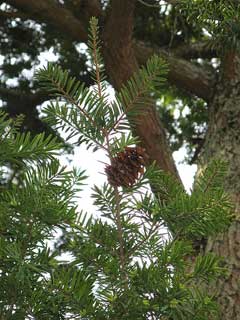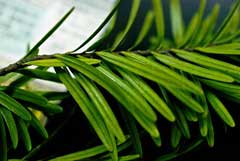 |
|
http://commons.wikimedia.org/wiki/User:KENPEI |
 |
| http://www.flickr.com/people/79319797@N00 |
Translate this page:
Summary
Physical Characteristics

 Keteleeria davidiana is an evergreen Tree growing to 30 m (98ft 5in).
Keteleeria davidiana is an evergreen Tree growing to 30 m (98ft 5in).
See above for USDA hardiness. It is hardy to UK zone 7 and is not frost tender. It is in leaf all year, in flower in March, and the seeds ripen from October to November. The species is monoecious (individual flowers are either male or female, but both sexes can be found on the same plant) and is pollinated by Wind.
Suitable for: light (sandy) and medium (loamy) soils and prefers well-drained soil. Suitable pH: mildly acid, neutral and basic (mildly alkaline) soils. It cannot grow in the shade. It prefers dry or moist soil.
UK Hardiness Map
US Hardiness Map
Synonyms
Plant Habitats
Woodland Garden Canopy;
Edible Uses
References More on Edible Uses
Medicinal Uses
Plants For A Future can not take any responsibility for any adverse effects from the use of plants. Always seek advice from a professional before using a plant medicinally.
None known
References More on Medicinal Uses
The Bookshop: Edible Plant Books
Our Latest books on Perennial Plants For Food Forests and Permaculture Gardens in paperback or digital formats.

Edible Tropical Plants
Food Forest Plants for Hotter Conditions: 250+ Plants For Tropical Food Forests & Permaculture Gardens.
More

Edible Temperate Plants
Plants for Your Food Forest: 500 Plants for Temperate Food Forests & Permaculture Gardens.
More

More Books
PFAF have eight books available in paperback and digital formats. Browse the shop for more information.
Shop Now
Other Uses
Wood
Wood - soft, light, resinous, close grained, easily worked. It is esteemed for building purposes, furniture and wood fibre[61, 109, 266].
Special Uses
References More on Other Uses
Cultivation details
Requires a sheltered position in a moist but well-drained light loamy soil with added leafmold[1]. Plants require a hot dry site if they are to flourish[81], with at least 4 months of temperatures above 25°c[200]. They grow best in a Mediterranean climate[200]. A tree at Wakehurst Place, south of London, was 14 metres tall in 1980[11]. Trees are slow growing in Britain[185] and are rather tender when they are young[1]. The new growth can be damaged by late spring and early autumn frosts[81]. Trees should be planted into their permanent positions when they are quite small, between 30 and 90cm in height. Larger trees will check badly and hardly put on any growth for several years. Planting out larger trees also badly affects root development and wind resistance[200]. Trees can be coppiced[200]. Plants do not produce seed in Britain[185].
References Carbon Farming Information and Carbon Sequestration Information
Temperature Converter
Type a value in the Celsius field to convert the value to Fahrenheit:
Fahrenheit:
The PFAF Bookshop
Plants For A Future have a number of books available in paperback and digital form. Book titles include Edible Plants, Edible Perennials, Edible Trees,Edible Shrubs, Woodland Gardening, and Temperate Food Forest Plants. Our new book is Food Forest Plants For Hotter Conditions (Tropical and Sub-Tropical).
Shop Now
Plant Propagation
Seed - sow in a sandy soil in a warm greenhouse in the spring[1]. When they are large enough to handle, prick the seedlings out into individual pots and grow them on in the greenhouse for at least their first winter. Plant them out into their permanent positions in late spring or early summer, after the last expected frosts. Consider giving the plants some protection from winter cold for their first two winters outdoors. Cuttings of leading shoots from coppiced plants, summer in a frame[200].
Other Names
If available other names are mentioned here
Native Range
TEMPERATE ASIA: China (Gansu Sheng (southeast), Guangxi Zhuangzu Zizhiqu (north), Guizhou Sheng, Hubei Sheng (west), Hunan Sheng (southwest), Shaanxi Sheng (south), Sichuan Sheng (southeast), Yunnan Sheng), Taiwan
Weed Potential
Right plant wrong place. We are currently updating this section.
Please note that a plant may be invasive in one area but may not in your area so it's worth checking.
Conservation Status
IUCN Red List of Threatened Plants Status :

Growth: S = slow M = medium F = fast. Soil: L = light (sandy) M = medium H = heavy (clay). pH: A = acid N = neutral B = basic (alkaline). Shade: F = full shade S = semi-shade N = no shade. Moisture: D = dry M = Moist We = wet Wa = water.
Now available:
Food Forest Plants for Mediterranean Conditions
350+ Perennial Plants For Mediterranean and Drier Food Forests and Permaculture Gardens.
[Paperback and eBook]
This is the third in Plants For A Future's series of plant guides for food forests tailored to
specific climate zones. Following volumes on temperate and tropical ecosystems, this book focuses
on species suited to Mediterranean conditions—regions with hot, dry summers and cool, wet winters,
often facing the added challenge of climate change.
Read More
Expert comment
Author
(Bertrand.)Beissner.
Botanical References
11109200
Links / References
For a list of references used on this page please go here
Readers comment
© 2010, Plants For A Future. Plants For A Future is a charitable company limited by guarantee, registered in England and Wales. Charity No. 1057719, Company No. 3204567.